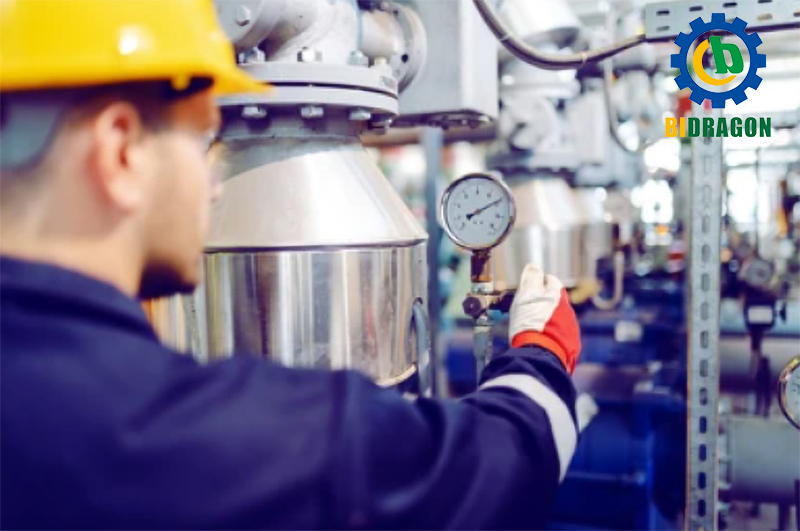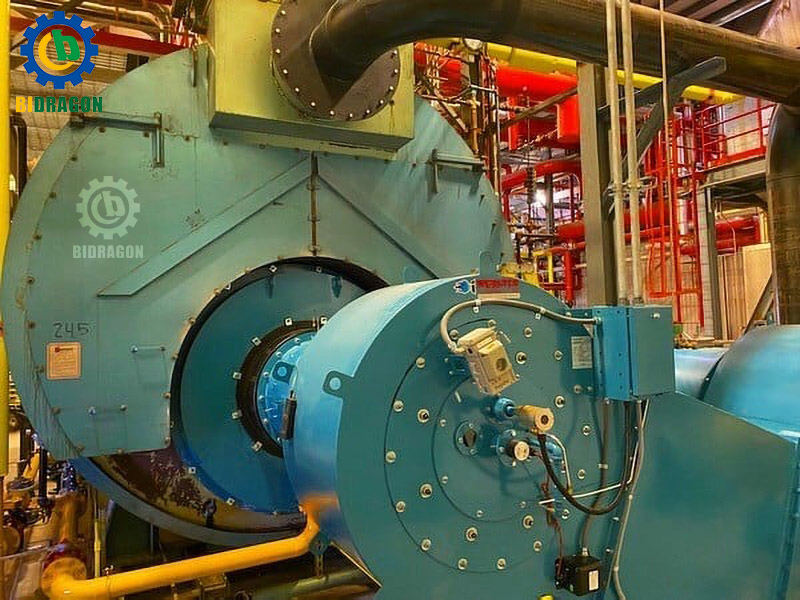In industrial production, boiler as a key heat supply equipment, its operating efficiency and stability directly affect the entire production process. The boiler turndown ratio is one of the most important indicators of boiler performance. Boiler turndown ratio specifically refers to the ratio of the burner’s maximum stable firing rate to its minimum stable firing rate under safe and efficient operation. This metric is critical for evaluating the boiler’s ability to adapt to varying heat demands. This ratio reflects the boiler's ability to adjust under different load demands.
For industrial boilers, the regulation ratio is crucial. The load demand of industrial production often has large fluctuations, for example, in the production of peak hours, the demand for heat energy increases sharply; while in the production of low production or equipment maintenance time, the demand for heat energy drops sharply. Boilers with appropriate adjustment ratios can flexibly adapt to such load changes to ensure the continuity and stability of production, and at the same time can also realize the efficient use of energy and reduce operating costs.

The basics of boiler turndown ratio is the key to understanding its performance. It clearly defines the range of combustion that can be adjusted during boiler operation. As mentioned earlier, it is calculated as the maximum firing rate divided by the minimum firing rate.
For example, a burner with a maximum firing rate of 5,000,000 BTU/hr and a minimum firing rate of 1,000,000 BTU/hr would have a turndown ratio of 5:1.
Different turndown ratios mean that the boiler has different abilities to cope with load variations; a turndown ratio of 5:1 means that the boiler can operate steadily from 20% to 100% of the maximum load, while a turndown ratio of 10:1 means that the boiler can flexibly adjust from 10% to 100% of the maximum load. Higher turndown ratios give the boiler greater adaptability and enable it to operate consistently over a wider range of loads.
Energy efficiency improvement: Industrial boilers with high turndown ratios reduce short-cycling. Short-cycling is when a boiler frequently switches between high and low loads, consuming additional energy with each start and stop. When the boiler has a high modulation ratio, it can reduce the combustion rate at low load demand and run continuously and stably, avoiding frequent startups and stops, thus significantly reducing fuel consumption and improving energy efficiency.
Cost savings: Reducing frequent starts and stops not only reduces fuel costs, it also reduces maintenance and operating costs. Each start and stop of the boiler generates mechanical and thermal stresses on various parts of the equipment, accelerating wear and aging of the parts. A high modulation ratio boiler reduces the number of starts and stops, which extends equipment life and reduces the frequency of repairs and replacement of components, which in turn reduces maintenance costs. At the same time, the stable operating condition also reduces the need for manual monitoring and intervention, lowering operating costs.
Environmental benefits: In today's world of increasingly stringent environmental requirements, high modulation ratio boilers help reduce emissions. A stable combustion process enables the fuel to burn more fully, reducing pollutants from incomplete combustion such as carbon monoxide and nitrogen oxides. This makes it easier for boiler emissions to comply with environmental regulations, avoiding the fines and rectification faced for exceeding emission standards, and also helps companies establish a good environmental image.
Stability enhancement: Load fluctuations are unavoidable during industrial production. With its flexible adjustment capability, the high adjustment ratio boiler can quickly adapt to the load changes and ensure the stable supply of steam or hot water. Whether it is to satisfy a large amount of thermal energy demand during the peak production period or to maintain the necessary heat supply during the trough period, it can maintain a stable operating condition and provide a reliable guarantee for industrial production.
Unstable combustion: At low load conditions, the fuel-to-air mixture becomes harder to maintain properly, leading to unstable flames or even flameout. This is particularly problematic for low turndown ratio burners, where precise control of fuel and air is limited.
Due to the low combustion ratio, the flame is easily disturbed by external factors, such as changes in wind speed and air pressure, resulting in unstable flame or even extinguishing, which affects the normal operation of the boiler.
Excessive air demand: In order to keep combustion stable at low loads, low regulation ratio boilers often need to supply more air. However, too much air will lower the combustion temperature, further affecting the combustion efficiency and increasing fuel consumption, as well as leading to an increase in heat loss from the exhaust flue, reducing the overall thermal efficiency of the boiler.
Hospitals, industrial manufacturing: Hospitals have extremely high requirements for stability and continuity of heat supply, and need to meet the demand for ward heating, hot water supply and steam for medical equipment at any time. In industrial manufacturing, such as chemical and food processing industries, the production process requires strict control accuracy of temperature and pressure, and the load fluctuates greatly. These scenarios are suitable for industrial boilers with high regulation ratios to ensure stable and efficient heat supply.
Small commercial facilities: For small commercial facilities, such as small restaurants and stores, their heat demand is relatively small and load fluctuations are relatively stable. A boiler with a medium regulation ratio can meet its daily operating requirements, which can ensure a certain degree of flexibility in regulation, but also achieve a better balance between cost and performance.
To select the right boiler turndown ratio, the first thing to consider is the load fluctuation of the plant. If the plant's production load is highly variable, with significant differences in heat demand at different times of the day, then a boiler with a relatively high turndown ratio needs to be selected to ensure stable operation under a variety of load conditions. On the other hand, if the load is relatively stable, a boiler with a medium regulation ratio can meet the demand.
In addition, the type of boiler and the type of fuel will also have an impact on the choice of regulation ratio. Different types of boilers, such as water-tube boilers and fire-tube boilers, have different structures and working principles, and have different regulation capabilities. In terms of fuel type, natural gas is characterized by high combustion efficiency and good regulation performance, which is suitable for use in occasions with high requirements on regulation ratio; while oil-fired boilers are relatively weak in regulation performance. When selecting a boiler, these factors need to be considered in order to determine the best regulation ratio for the plant's needs.
Burner design is one of the most important factors affecting boiler turndown ratio. The modulating burner has more flexible adjustment function and can precisely adjust the ratio of fuel and air supply according to the load change, thus realizing a wider combustion adjustment range and improving the boiler turndown ratio. The on-off burner can only be switched between fully open and fully closed states, and has limited adjusting capability, and is usually used in applications where the adjusting ratio is not required to be high.
In general, larger boilers usually have a higher modulation ratio. This is because large boilers have a greater heat storage capacity and are better able to maintain a stable operating state when the load changes. At the same time, the combustion system and control system of large boilers are relatively more complex and advanced, and they have a stronger regulating ability to adapt to a wider range of load changes.
Different fuels have different combustion characteristics, which also have an impact on the boiler regulation ratio. Natural gas combustion speed, combustion stability, easy to adjust, can support a higher regulation ratio. The viscosity and atomization properties of fuel oil, on the other hand, affect the stability and adjustability of the combustion process, and in contrast, oil-fired boilers usually have lower regulation ratios than natural gas boilers. In addition, other fuels, such as biomass fuels, are more difficult to regulate due to the complexity of their compositions and combustion characteristics, and their regulation ratios are also relatively low.

There is no fixed standard for the ideal turndown ratio of an industrial boiler, it depends on the specific application and the load demand of the plant. For industries with large load fluctuations and high requirements for heat supply stability, such as chemical and pharmaceutical industries, the ideal turndown ratio may be 10:1 or even higher; while for small businesses with relatively stable loads, a turndown ratio of 5:1 or 6:1 may be sufficient to meet the demand.
Under certain conditions, it is possible to retrofit an existing boiler to improve the modulating ratio. Common modifications include replacing the burner with a better regulator, upgrading the control system, and so on. However, the overall structure and performance of the boiler needs to be evaluated before retrofitting to ensure the feasibility and safety of the retrofit. At the same time, the retrofit may require a certain cost investment, and the return on investment needs to be considered comprehensively.
Normally, the initial cost of a boiler with a high modulating ratio is indeed relatively higher due to more advanced combustion and control systems. However, in the long run, the benefits of higher modulation ratios in terms of energy savings, lower maintenance costs, etc., can often make up for the increase in initial costs and even realize higher economic benefits.
Higher ratio boilers reduce frequent startups and shutdowns, which reduces wear and aging of equipment components, resulting in less frequent maintenance and lower maintenance costs. Low regulation ratio boilers, on the other hand, are prone to component damage due to frequent startups and stops and unstable combustion at low loads, increasing maintenance workload and costs. Therefore, choosing the appropriate regulation ratio helps to reduce the maintenance difficulty and cost of the boiler.
In summary, boiler regulation ratio plays a crucial role in the operation of industrial boilers. It directly affects the energy efficiency, cost, environmental performance and operational stability of the boiler. In industrial production, choosing the appropriate regulation ratio according to the actual load demand of the plant, boiler type and fuel type can optimize the operation of the boiler system and achieve efficient use of energy and effective control of costs.
In order to ensure the efficient operation of the boiler system, it is recommended that enterprises seek professional technical support and consulting services when selecting the boiler adjustment ratio. Professionals can be based on the specific circumstances of the enterprise, to carry out a detailed analysis and assessment, to provide the most suitable boiler ratio program, help enterprises to improve production efficiency, reduce operating costs, and achieve sustainable development.